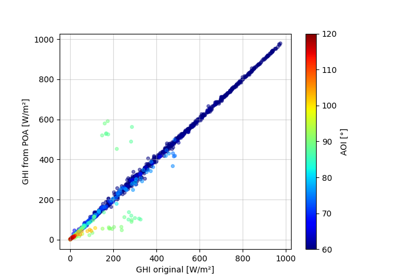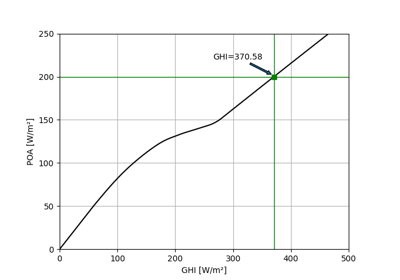pvlib.irradiance.ghi_from_poa_driesse_2023#
- pvlib.irradiance.ghi_from_poa_driesse_2023(surface_tilt, surface_azimuth, solar_zenith, solar_azimuth, poa_global, dni_extra, airmass=None, albedo=0.25, xtol=0.01, full_output=False)[source]#
Estimate global horizontal irradiance (GHI) from global plane-of-array (POA) irradiance. This reverse transposition algorithm uses a bisection search together with the continuous Perez-Driesse transposition and continuous Erbs-Driesse decomposition models, as described in [1].
- Parameters:
surface_tilt (numeric) – Panel tilt from horizontal. See surface_tilt. [°]
surface_azimuth (numeric) – Panel azimuth. See surface_azimuth. [°]
solar_zenith (numeric) – Solar zenith angle. See solar_zenith. [°]
solar_azimuth (numeric) – Solar azimuth angle. See solar_azimuth. [°]
poa_global (numeric) – Plane-of-array global irradiance, aka global tilted irradiance. See poa_global. [Wm⁻²]
dni_extra (numeric) – Extraterrestrial direct normal irradiance. See dni_extra. [Wm⁻²]
airmass (numeric, optional) – Relative airmass (not adjusted for pressure). See airmass_relative. [unitless]
albedo (numeric, default 0.25) – Ground surface albedo. See albedo. [unitless]
xtol (numeric, default 0.01) – Convergence criterion. The estimated GHI will be within
xtolof the true value. Must be positive. [Wm⁻²]full_output (boolean, default False) – If full_output is False, only
ghiis returned, otherwise the return value is (ghi,converged,niter). (see Returns section for details).
- Returns:
ghi (numeric) – Estimated global horizontal irradiance. See ghi. [Wm⁻²]
converged (boolean, optional) – Present if full_output=True. Indicates which elements converged successfully.
niter (integer, optional) – Present if full_output=True. Indicates how many bisection iterations were done.
Notes
Since
scipy.optimize.bisect()is not vectorized, high-resolution time series can be quite slow to process.References
See also
Examples using pvlib.irradiance.ghi_from_poa_driesse_2023#

Reverse transposition using one year of hourly data

